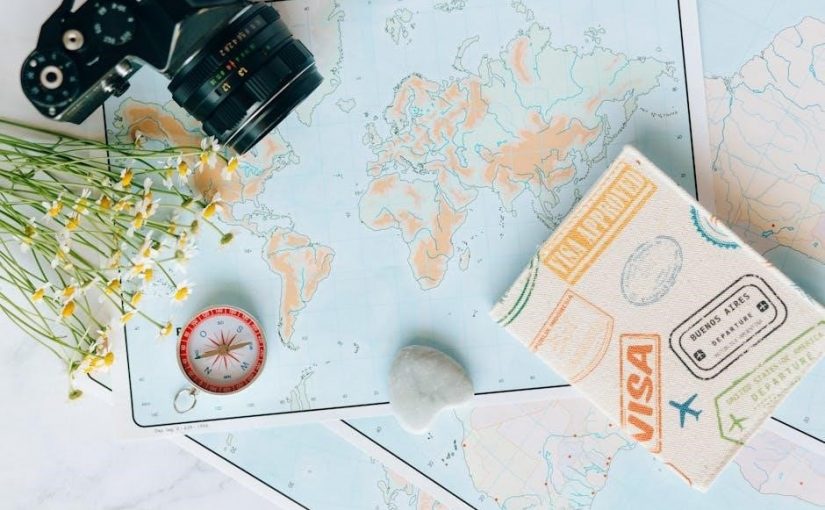The Philippines, an archipelago in Southeast Asia, comprises over 7,000 islands. Known for its diverse culture, lush landscapes, and tropical climate, it’s a vibrant destination. Manila, the capital, blends historical charm with modern city life, while the nation’s friendly locals and rich heritage make it a must-visit.
1.1 Geography and Climate
The Philippines is an archipelago with over 7,000 islands, located in Southeast Asia. Its geography features lush mountains, vast plains, and stunning coastlines. The climate is tropical, divided into wet and dry seasons, with temperatures averaging 22–32°C. The country is prone to typhoons and lies on the Pacific Ring of Fire, making it geologically active. Its diverse ecosystems include coral reefs, rainforests, and volcanic landscapes, making it a biodiversity hotspot. The varied geography and climate create a unique environment for both relaxation and adventure, attracting tourists worldwide.
1.2 Brief History and Culture
The Philippines boasts a rich cultural heritage shaped by its history. The archipelago was influenced by Spanish colonization, which introduced Christianity and European traditions. Later, American rule brought English and modern education. This blend of cultures, along with indigenous traditions, creates a unique identity. Filipino culture is known for its hospitality, respect for elders, and vibrant festivals. The country’s history is reflected in its landmarks, art, and customs, offering a fascinating glimpse into its past. This cultural diversity makes the Philippines a captivating destination for exploring traditions and historical narratives.
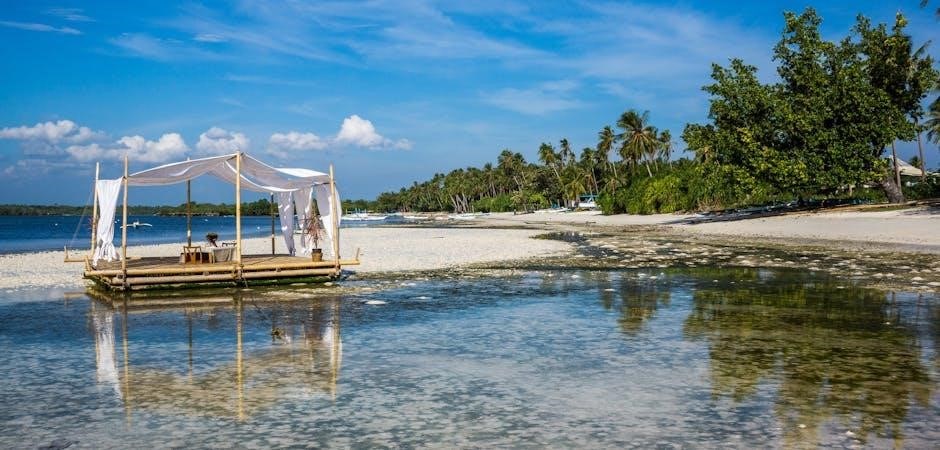
Popular Tourist Destinations
The Philippines is renowned for its stunning beaches, vibrant cities, and breathtaking landscapes. Key attractions include Manila, Cebu, and Boracay, offering rich history, adventure, and relaxation.
2.1 Manila: The Capital City
Manila, the bustling capital of the Philippines, is a melting pot of history, culture, and modernity. Intramuros, the historic walled city, features iconic landmarks like Fort Santiago and Manila Cathedral. Museums, such as the National Museum of the Philippines, showcase the country’s rich heritage. The vibrant Bonifacio Global City offers shopping, dining, and entertainment, while local markets like Divisoria provide a glimpse into the city’s bustling trade. Manila’s blend of colonial architecture, cultural attractions, and lively atmosphere makes it a must-visit destination for travelers exploring the Philippines.
2.2 Cebu: The Queen City of the South
Cebu, known as the Queen City of the South, is a vibrant mix of history, culture, and natural beauty. Visit Magellan’s Cross, a historic landmark marking the arrival of Spanish colonizers, and the Basilica del Santo Niño, one of the oldest churches in the Philippines. The city also boasts stunning beaches, waterfalls, and diving spots, such as Moalboal and Bantayan Island. Cebu’s iconic Sinulog Festival, a colorful celebration of faith and culture, attracts visitors worldwide. This captivating destination offers a perfect blend of adventure, heritage, and modern charm for every traveler.
2.3 Boracay: The Beach Paradise
Boracay, a tiny island in the Philippines, is renowned for its stunning beaches and vibrant nightlife. White Beach, with its powdery sand and crystal-clear waters, is a must-visit. The island offers a variety of activities, including snorkeling, diving, and parasailing. D’Mall, the heart of Boracay, provides a lively atmosphere with shops, restaurants, and bars. For a more serene experience, visit WilWil’s Rock or Tambisaan Beach. Don’t miss the iconic Boracay crusty bread, a local delicacy. The island’s laid-back vibe and stunning sunsets make it a perfect destination for relaxation and adventure.
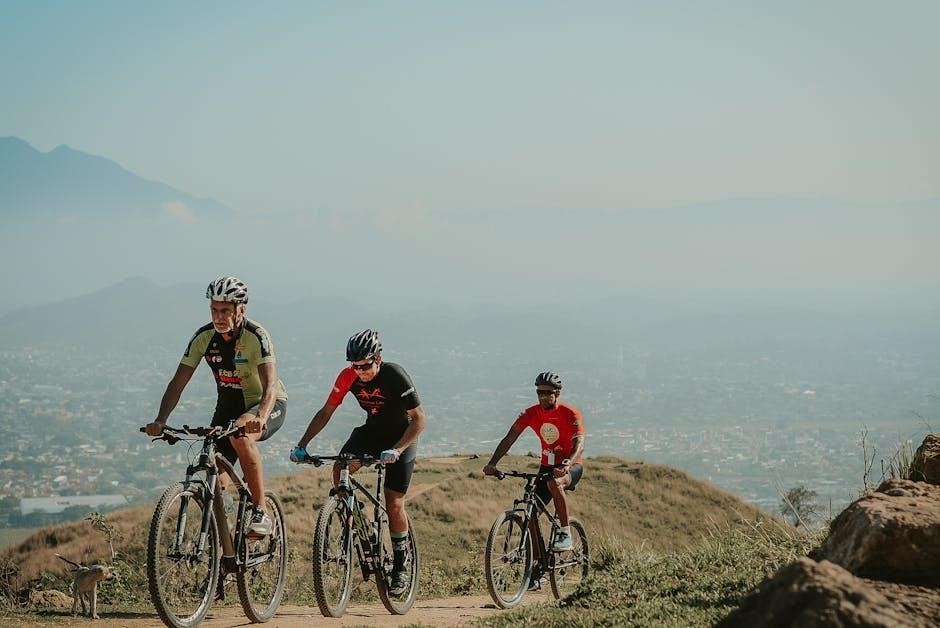
Cultural Highlights
The Philippines is a vibrant mix of indigenous, Spanish, and American influences. Its culture is rich in traditions, hospitality, and family values. Experience the nation’s creative expressions through music, dance, and art, showcasing its deep heritage and warm, welcoming people.
3.1 Festivals and Celebrations
The Philippines is renowned for its vibrant festivals, showcasing its rich cultural heritage. Sinulog in Cebu and Ati-Atihan in Kalibo honor the Santo Niño with colorful parades and music. Meanwhile, the Pahiyas Festival in Lucban features houses adorned with rice grains and flowers. These celebrations highlight Filipino creativity, faith, and joy, attracting locals and tourists alike. Festivals often include traditional dances, food, and music, reflecting the nation’s deep-rooted traditions and warm hospitality. They are a testament to the Philippines’ lively culture and its people’s love for celebration and community bonding.
3.2 Historical Landmarks
The Philippines boasts a rich history reflected in its iconic landmarks. Intramuros, the “Walled City,” stands as a testament to Spanish colonial rule, featuring Fort Santiago and Manila Cathedral. The Barasoain Church in Malolos is hailed as the birthplace of the First Philippine Republic. Magellan’s Cross in Cebu marks the arrival of Christianity. These sites, along with the Chocolate Hills and the Philippine National Museum, showcase the country’s diverse history, blending indigenous, Spanish, and American influences. They attract history enthusiasts and offer a glimpse into the nation’s cultural and historical tapestry.
3.3 Local Cuisine and Food Culture
Filipino cuisine is a vibrant blend of Spanish, Chinese, and Malay influences. Popular dishes include lechon (roasted pig), adobo (meat or fish in vinegar and soy sauce), and sinigang (sour soup). Street food like balut (fertilized duck egg) and kwek kwek (quail eggs in orange batter) are must-tries. The Philippines is also known for its fresh seafood and tropical fruits like mangoes and durian. Food plays a central role in culture, with feasts and festivals showcasing the nation’s love for flavorful and hearty meals. Dining is often a communal experience, reflecting the Filipino spirit of hospitality and togetherness.
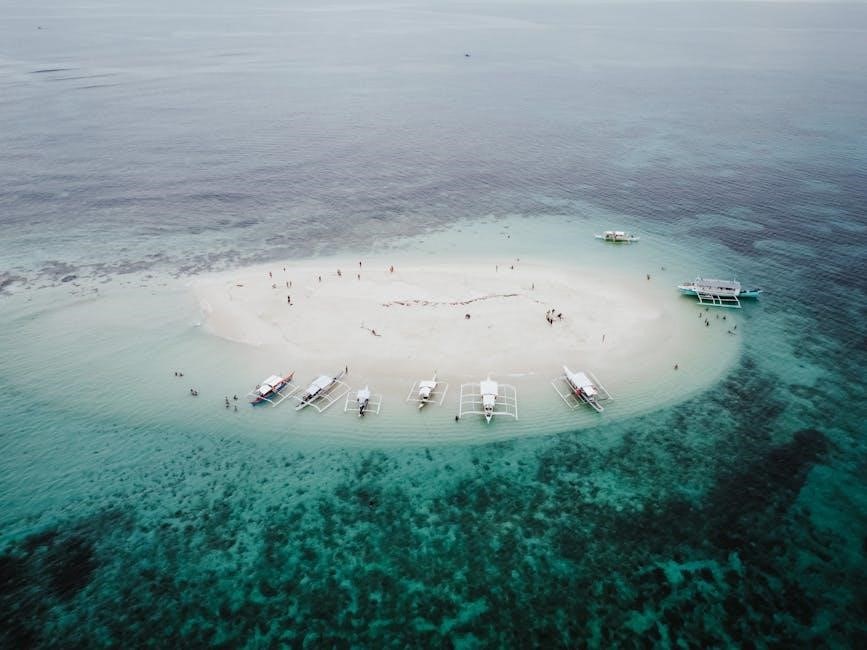
Outdoor Activities
The Philippines offers diverse outdoor activities like island hopping, snorkeling, and hiking. Its lush landscapes and tropical climate make it perfect for nature enthusiasts and adventurers alike.
4.1 Best Beaches and Islands
The Philippines is renowned for its stunning beaches and islands. Boracay, with its white sandy shores and crystal-clear waters, is a top destination. Palawan boasts iconic spots like El Nido and Coron, offering breathtaking lagoons and coral reefs. Cebu’s Bantayan Island and Siargao’s surfing beaches are also favorites. These destinations provide endless opportunities for snorkeling, diving, and island hopping. The Philippines’ tropical paradise is a haven for beach lovers, with its natural beauty and vibrant marine life creating unforgettable experiences for travelers.
4.2 Diving and Snorkeling Spots
The Philippines is a paradise for diving and snorkeling enthusiasts. Tubbataha Reefs Natural Park, a UNESCO World Heritage Site, offers stunning coral reefs and diverse marine life. El Nido and Coron in Palawan are famous for their crystal-clear waters, underwater caves, and WWII shipwrecks. Apo Reef, the largest coral reef in the country, is another must-visit spot. Moalboal in Cebu is known for its sardine runs and vibrant marine biodiversity. These destinations provide unforgettable experiences for both beginners and experienced divers, showcasing the Philippines’ rich underwater treasures.
4.3 Adventure and Trekking
The Philippines offers thrilling adventure and trekking opportunities. Mayon Volcano, with its perfect cone, is a popular hiking destination. Taal Volcano, located in a lake, provides a unique trekking experience. Mount Pinatubo, famous for its 1991 eruption, features stunning landscapes and a crater lake. The Cordillera Mountains offer challenging trails with breathtaking views of lush forests and traditional villages. Trekking through these regions allows visitors to immerse themselves in nature and experience the rich cultural heritage of the Igorot people. These adventures showcase the Philippines’ diverse ecosystems and rugged beauty, making it a paradise for outdoor enthusiasts.

Travel Tips
Plan ahead, respect local customs, stay hydrated, and use reliable transport. Learn basic Filipino phrases for a smoother journey and pack essentials like sunscreen and insect repellent.
5.1 Visa Requirements and Regulations
Visitors to the Philippines typically need a valid passport and may require a visa, depending on nationality. Citizens of many countries are eligible for a visa-free stay of up to 30 days. To apply, submit a completed visa form, passport, recent photo, and proof of onward travel. Processing times vary, so apply in advance. Overstaying can result in fines or deportation. Check the Philippine Bureau of Immigration website for the latest requirements. Ensure all documents are valid for at least six months beyond your planned departure date to avoid entry issues.
5.2 Vaccinations and Health Precautions
Travelers to the Philippines should ensure they are up-to-date on routine vaccinations. Hepatitis A, Typhoid, and Rabies are commonly recommended due to the risk of exposure. If visiting rural or forested areas, consider vaccination against Japanese Encephalitis; COVID-19 restrictions may still apply, so check current entry requirements. Stay hydrated, use sunscreen, and avoid undercooked food to prevent waterborne and foodborne illnesses. Insect repellents are essential to reduce the risk of Dengue and Zika. Consult your healthcare provider before traveling, especially if you have pre-existing conditions. Carry a first-aid kit and know the location of reliable medical facilities, particularly in Manila and Cebu. Always purchase travel insurance that covers medical emergencies;
5.3 Safety Tips for Tourists
Exercise caution in crowded areas to avoid petty theft and scams. Secure valuables, especially in public transport and markets. Use reputable taxi services or ride-sharing apps. Stay informed about local conditions, as some regions may have travel advisories. Avoid traveling alone at night in isolated areas. Respect local customs and dress modestly when visiting churches or attending festivals. Stay updated on weather conditions, as typhoons can occur. Swim in designated areas and avoid risky water activities during rough seas. Always carry a copy of important documents and keep emergency contact numbers handy. Enjoy your trip responsibly and be mindful of your surroundings.

Accommodation Options
The Philippines offers diverse accommodations, from budget-friendly hotels and hostels to luxury resorts and unique stays, catering to all preferences and ensuring a memorable experience for every traveler.
6.1 Budget-Friendly Hotels and Hostels
Budget travelers will find affordable yet comfortable accommodations in the Philippines. Hostels like Z Hostel in Manila and Cebu’s Napsule offer dorms and private rooms at low rates. Many budget hotels provide free Wi-Fi, breakfast, and convenient locations near public transport. Popular chains include RedDoorz and Tune Hotels, which cater to cost-conscious visitors. These options are ideal for solo travelers or groups, ensuring a cozy stay without breaking the bank. Booking platforms like Agoda and Hostelworld make it easy to find these deals, allowing travelers to explore the Philippines’ beauty on a budget.
6.2 Luxury Resorts and Spas
The Philippines boasts world-class luxury resorts and spas, offering unparalleled comfort and elegance. Amanpulo in Palawan and El Nido Resorts are top choices, featuring private villas, fine dining, and stunning ocean views. Many resorts offer exclusive activities like snorkeling, diving, or private yacht tours. Spas like The Farm at San Benito provide holistic wellness programs, combining traditional therapies with modern amenities. For a luxurious stay, resorts in Cebu, such as Shangri-La Mactan, offer upscale accommodations with infinity pools and beachfront access. These destinations cater to travelers seeking a lavish and rejuvenating experience in a tropical paradise.
6.3 Unique Accommodation Experiences
The Philippines offers diverse and unique accommodation options for adventurous travelers. From treehouse stays in the mountains to overwater villas in crystal-clear lagoons, these experiences provide unforgettable memories. Eco-lodges and glamping sites allow guests to connect with nature while enjoying modern comforts. Community-based stays, like traditional Ifugao huts in the Cordilleras, offer cultural immersion. Some resorts even feature floating cottages or lighthouse inns, blending tranquility with breathtaking views. These distinctive accommodations cater to travelers seeking more than just a place to stay, offering a chance to live like locals or indulge in extraordinary settings.
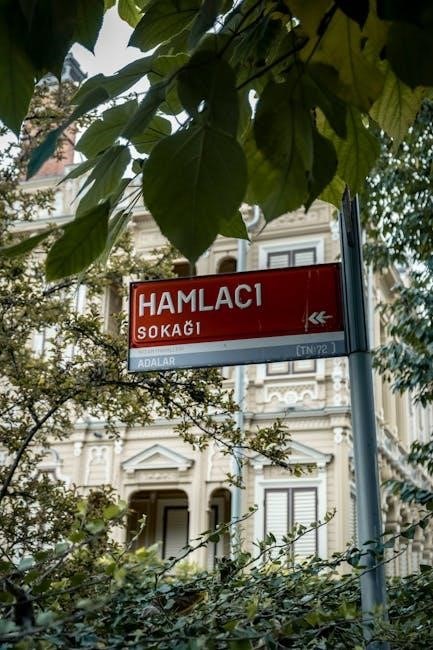
Transportation Guide
The Philippines offers various transportation options, including jeepneys, buses, and tricycles for land travel. Domestic flights and ferries connect islands efficiently, while Grab and taxis provide city convenience.
7.1 Public Transportation in the Philippines
Public transportation in the Philippines is affordable and diverse. Jeepneys, colorful buses, and tricycles are popular modes, offering cheap fares for short distances. In Manila, the LRT and MRT provide efficient rail services. ferries connect coastal areas, while Grab and taxis are widely available for convenience. Many locals rely on these systems, making them accessible to tourists. For longer trips, buses and vans are ideal. With a mix of traditional and modern options, public transport in the Philippines is both practical and culturally immersive, allowing visitors to explore the country with ease and affordability.
7.2 Renting Cars or Motorcycles
Renting cars or motorcycles is a convenient way to explore the Philippines. Major rental companies offer sedans, SUVs, and motorcycles, ideal for both city trips and rural adventures. Popular options include local firms and international brands like Hertz. A valid driver’s license and credit card are typically required. Daily rates vary, with cars starting at ₱1,500–₱3,000 and motorcycles at ₱400–₱800. Always inspect the vehicle, check insurance coverage, and review the rental agreement. Motorcycles are great for navigating narrow roads, while cars provide comfort for longer journeys. Book in advance, especially during peak seasons, for a seamless experience.
7.3 Domestic Flights and Ferries
Domestic flights and ferries are essential for navigating the Philippines’ vast archipelago. Major airlines like Cebu Pacific and Philippine Airlines offer frequent flights between key cities, reducing travel time significantly. Ferries, such as 2GO Travel, connect islands and are ideal for budget-friendly travel. Popular routes include Manila to Cebu and Batangas to Puerto Galera. Book flights in advance for discounts and arrive early at ferry terminals. Flights provide convenience, while ferries offer scenic views, making both options popular for exploring the country’s diverse destinations.

Language and Communication
The Philippines has two official languages: English and Filipino (based on Tagalog). English is widely spoken, especially in tourist areas, making communication easy for international visitors.
8.1 Official Languages and Dialects
The Philippines has two official languages: English and Filipino, with Filipino based on Tagalog. English is widely spoken, particularly in business, education, and tourism. Over 180 languages and dialects are spoken across the archipelago, reflecting its cultural diversity. Major dialects include Cebuano, Ilocano, and Hiligaynon. This linguistic richness allows for vibrant communication, with English serving as a unifying bridge for both locals and international visitors, ensuring smooth interactions during travel and daily life in the country.
8.2 Common Phrases for Tourists
English is widely spoken in the Philippines, making communication easy for tourists. Key phrases include “Good morning/afternoon/evening” (Magandang umaga/hapon/gabi), “Thank you” (Salamat), and “How much is this?” (Magkano ito?). Asking for directions with “Where is…?” (Nasaan ang…?) is common. Numbers in Filipino are also helpful: “One” (Isa), “Two” (Dalawa), and “Three” (Tatlo). Basic phrases like “Excuse me” (Paumanhin) and “I’m lost” (Nawawala ako) can be lifesavers. Using these simple expressions shows respect for the culture and enhances your travel experience.
Etiquette and Cultural Norms
Respect elders by using “po” or “opo” when speaking. Remove shoes before entering homes or traditional areas. Public displays of affection are rare, and modest dress is appreciated.
9.1 Respect for Local Traditions
In the Philippines, respecting local traditions is essential. Filipinos value their customs deeply, especially during festivals and religious events. When attending a mass or visiting a church, dress modestly and maintain silence. The “pahalik” gesture, where elders’ hands are kissed, is a sign of respect. Avoid public criticism of traditions, as this may offend locals. Understanding and appreciating these customs enhances your cultural experience and fosters positive interactions with the community.
9.2 Dress Code and Social Behavior
In the Philippines, modest clothing is recommended, especially in churches and government offices. Avoid revealing outfits, as the culture remains conservative. When visiting mosques or temples, cover your shoulders and knees. In urban areas, casual attire is acceptable, but dress neatly for formal events. Public displays of affection are uncommon, so maintain discretion. Filipinos value politeness, so use phrases like “po” (sir/ma’am) and “opo” (yes) when speaking to elders. Removing shoes before entering homes is customary. Respect these norms to blend in and show cultural sensitivity during your visit.

Shopping and Souvenirs
The Philippines offers vibrant markets and unique souvenirs like handwoven fabrics, wooden carvings, and intricate jewelry. Visit local bazaars for authentic items and bargain-friendly prices.
10.1 Popular Shopping Destinations
The Philippines is a shopper’s paradise, with destinations like Divisoria in Manila offering affordable goods, from clothing to electronics. Greenhills Shopping Center is famous for pearl jewelry and gadgets. Bonifacio Global City in Taguig features upscale retail and dining experiences. SM Mall of Asia, one of Asia’s largest malls, offers a vast array of brands and entertainment options. These spots cater to diverse preferences, making shopping in the Philippines a memorable experience for both locals and tourists.
10.2 Must-Buy Souvenirs
The Philippines offers a variety of unique souvenirs that showcase its rich culture. Handmade crafts like woven fabrics from Ifugao and T’nalak textiles from Mindanao are popular choices. Jeepney miniatures, symbolizing the iconic Philippine transportation, are favorites among tourists. Pearl jewelry from Palawan and Cebu, known for their high quality, is a must-buy. Hand-carved wooden figurines and Ifugao bulul statues also make meaningful keepsakes. Don’t forget to bring home local products like coconut oil, organic skincare items, and specialty coffee from regions like Sagada and Batangas. These souvenirs blend tradition, artistry, and practicality, offering a taste of the Philippines’ vibrant heritage.
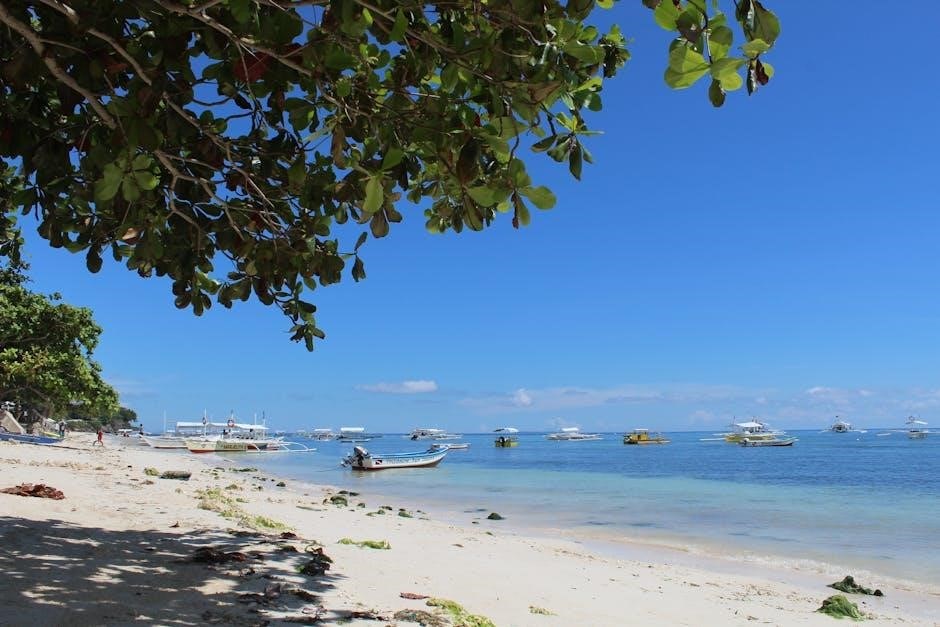
Sustainable Tourism
Engage in eco-friendly practices, support local communities, and respect wildlife. Reduce plastic use, choose green accommodations, and participate in conservation efforts to preserve the Philippines’ natural beauty responsibly.
11.1 Eco-Friendly Travel Tips
To promote sustainable tourism in the Philippines, adopt eco-friendly practices. Reduce plastic use by carrying reusable bottles and bags. Conserve water and energy in accommodations. Support eco-certified resorts and tour operators that follow environmental standards. Avoid touching or damaging coral reefs while snorkeling or diving. Respect wildlife and their habitats by not feeding or disturbing them. Participate in beach cleanups or conservation activities. Choose public transport, walk, or bike when possible to reduce carbon emissions. By embracing these habits, you help preserve the Philippines’ stunning natural beauty for future generations while making a positive impact on local ecosystems and communities.
11.2 Supporting Local Communities
Supporting local communities in the Philippines enriches your travel experience while benefiting residents. Shop at local markets and buy handmade crafts to directly contribute to artisans’ livelihoods. Dine at family-owned restaurants and try authentic dishes, which helps small businesses thrive. Stay in community-run accommodations or eco-lodges that reinvest profits into local development. Engage in tours led by local guides to gain authentic insights and support their families. By choosing local services, you empower communities, preserve traditions, and foster sustainable development. Your thoughtful choices create lasting positive impacts on the places you visit and the people you meet.
11.3 Responsible Wildlife Tourism
Engaging in responsible wildlife tourism is essential to preserving the Philippines’ rich biodiversity. Choose tour operators that follow ethical practices and support conservation efforts. Avoid activities that exploit animals, such as touching or riding marine life. Respect wildlife habitats by maintaining a safe distance and not littering. Support sanctuaries and national parks that prioritize animal welfare. Educate yourself about local species and their protection status. By practicing responsible tourism, you contribute to the conservation of the Philippines’ unique ecosystems and promote sustainable coexistence between humans and wildlife.
